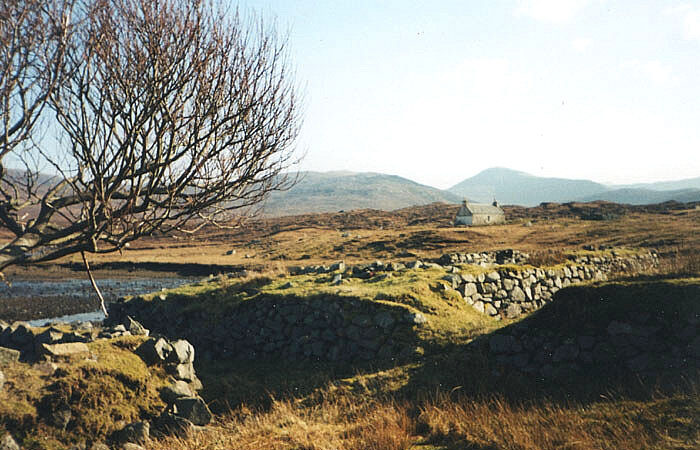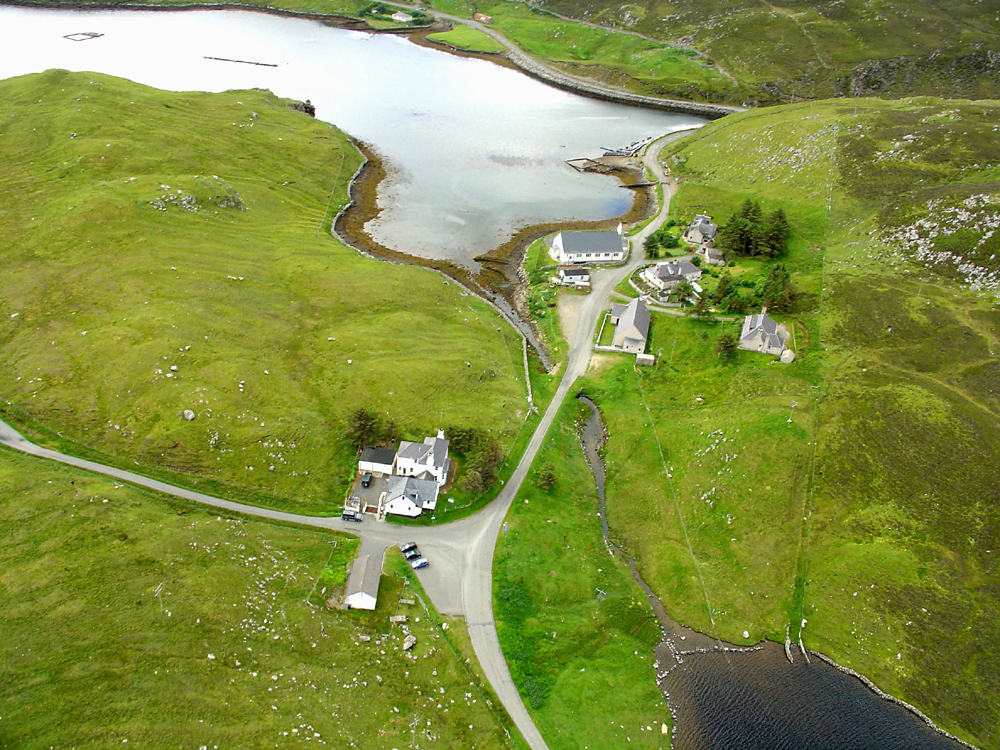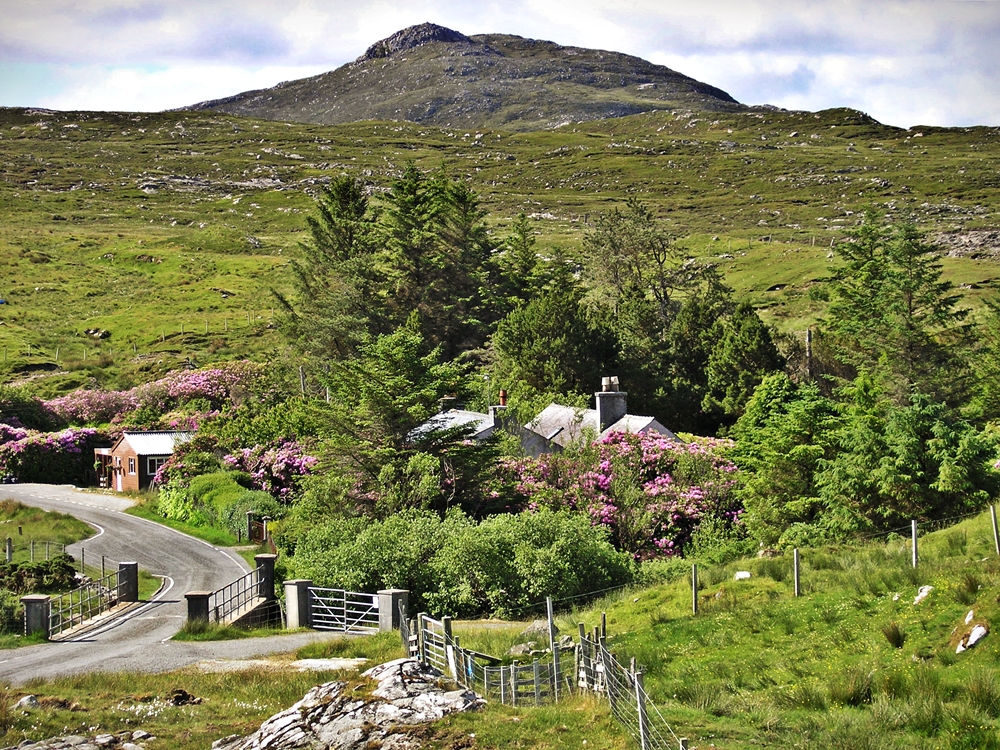Author: admin (page 24)
Origins of the Smiths
From Rev William Matheson (Mac Gille Chaluim), Families of Lewis (1959) in the Stornoway Gazette. Rev Matheson begins by explaining how he reckons the Smiths of Earshader (from whom are descended the Smiths of Strome, Valtos, Laxay and Keose) were Morrisons sometimes known as Mackinnons, before they acquired the surname Smith in English. He continues:
If we may take it that the clan surname of the Smiths of Earshader was Morrison alias Mackinnon (the latter representing Gaelic Mac Cianain and not Mac Fhionghuin as in Skye and Mull) we are not without some traditional information as to how the first of them came to the parish of Uig. In the Morrison manuscripts there are a number of traditions about a noted character whose career began as a personal attendant to Donald Cam Macaulay. His name calls for some comment, for it was misunderstood by Captain FWL Thomas [who wrote on the history of Uig families]. He calls him John Du Chroig, and explains this as Big-fisted Dark John. But the Gaelic for that would be Iain Dubh na Croige. The reading in the Morrison manuscripts is in fact “John du Chraik” and, better still, the tradition Gaelic form is still known in Uig and is Iain Dubh Chraidhig. This last word must be a place-name, but unfortunately we cannot identify it. It may be in Harris or in Uist. [A subsequent letter to the Gazette suggests it may be in Barra.]
The story in the Morrison manuscript is that the Lewis clans were concerned in the capture of a fully armed ship in Barra, sent, as was thought, to subjugate the Long Island. All the crew were killed, except a man with his wife and child, who were discovered to speak Gaelic. The child was Iain Dubh Chraidhig.
Matheson suggests that this story may relate to a historical event in 1610, from a letter written by Neil Macleod of Berisay, a close ally of Donald Cam.
Rev David Watson
A Brief Record of the Church in Uig
Some Uig Folk
Marbhrann air Iain Moireasdan
Miavaig, Carishader and the Bays in 1959
A chapter (abridged) by Annis Heawood from Uig: A Hebridean Parish (1960). Photo by Chris Murray.
The district here described includes Gisla, near the head of Little Loch Roag, Enaclete, Ungeshader and Geshader, on the western shores of Loch Roag proper. All these are strung out on or close to the main road. Miavaig, like Gisla, is a small farm but also functions as something of a metropolis for south Uig; it has the post master, whose other functions include registrar and receiver of wrecks, and it has two churches, a telephone exchange, the district doctor and mans, and a petrol pump. At the time of our visit it was also the base for the ‘bus service. Its metropolitan functions arose in the days before the road replaced a ferry boat service from Callanish; here the mails were landed until some date in the 1920s and here to the estate kept coach and horses for transport to Uig Lodge, three miles further west.
There is no record of the original settlement of the four crofting townships, nor of Gisla, which was a township or joint farm of five crofters until about 1850. Some modern houses and bungalows have been built, many with easier access to the road than the old black houses, now often used as byres. Water supply does not seem to present a serious problem because of the extensive moorland gathering grounds to the west, but there are not at present any water-supply schemes. Electricity is, of course, available. Carishader an Enaclete are on the main Stornoway road being served at present by the ‘bus and by vans selling meat, groceries and fish at least once a week. Enaclete has a sub-postoffice. Geshader is less fortunate since, although vans call regularly, ‘buses must be met at the junction of the unsurfaced track and the main Stornoway road, where the school serving this district also stands. The track has been extended in recent years so that it now reaches all the houses. Ungeshader, however , is smaller and although it has had similar delivery arrangements, it is now a dying settlement largely due to its inaccessibility.
Eathar na h-Airde
Murdo Crola

An account of the life of Murdo Macdonald, Crola, held by Bernera Historical Society (author unknown).
Although Murdo Macdonald was an Uigeach, born and bred, and of Uig parents, he was well known in Scarp and North Harris where many of his relations lived. His paternal grandmother was one of a well-known family of Macleans from Scarp while four of his father’s family (three sisters and a brother) married Scarpaich. These family connections caused him and his family to have constant intercourse between the two places.
Born on 13 January 1907 at Crola, Kinlochresort, son of Calum Macdonald and Catherine Maciver from Callanish, he was the youngest of the family. An older sister Kate, lived to an old age, while a brother Donald died in infancy. His father’s family originated from Skye and were said to be descended from the Macdonalds of Glencoe.
The Macdonald family were shepherds and were for some time employed at Bedersaig, North Harris. After one of the infamous clearances we find that John, Murdo’s grandfather, moved to Tealasvay in Uig, and afterwards to Crola, while his brother Donald moved to Luachair and afterwards to Cravadale as gamekeeper. The rest of the family left the district altogether.
From a very early age Murdo showed an exceptional ability for memorising anything he heard.
audio: Archangel Tar and Sealskin
Stone-Throwing Epidemic in Lochcroistean
More from Crowlista
Muinntir Dhubhain
Cornstacks in Brenish
Recruitment in 1793
From a manuscript by (as far as I can make out) Rev Col AJ Mackenzie, son of Roderick Mackenzie, gamekeeper at Luachair and Uig Lodge. According to tradition, men were compelled to join the army when Seaforth was raising the 78th Seaforth Highlanders in 1793. When he arrived in Lewis, the men of Uig took to the hills and established themselves at Cnoc a’Champ, near the site of Uig Lodge, and a boat rowed by women was sent to meet Seaforth at Callanish. Seaforth was not best pleased and set off with the minister, Rev Hugh Munro, to speak to the men. Rev Munro persuaded them to be more patriotic, and an assurance was given that only one son would be taken from a family, or two where the family was large. The minister’s own son, Ensign John Munro, was enlisted in 1804 and subsequently killed at Java. AJ Mackenzie here looks at the traditions surrounding the giving of the King’s shilling, particularly in light of the assertion by Chamberlain John Munro Mackenzie (grandson to Rev Munro and author of the published Diary of 1851) to the Napier Commission that enlisting was voluntary.
The primary object of Munro Mackenzie’s examination by Lord Napier’s Commission was apparently to discover what were the means employed by Seaforth and his officers in procuring recruits for his regiment – whether recruiting was by compulsion backed by threats of eviction, or by voluntary enlistment backed by promises of future reward.
This is a point on which I have never been able to find definite information. Mackenzie in his evidence was emphatic on the point that there was no compulsion of an sort, and so far as I know there was no recognised authority that could compel a man to join the army. Yet in the traditions of the people themselves there is the definite impression, whether mistaken or not, of a time when men were compelled to send their sons into the army. Again and again I have heard reference to a time when men were compelled by some authority to join the army – “an uair a bha iad ‘gan toirt air falbh do’n arm“. Four incidents bearing on this point occur to me.
There used to be pointed out on Fidean Eristeadh a remarkably wide ditch which was alleged to have been jumped by a young man of the village when pursued by soldiers who were seeking to apprehend him for military service. In this case, however, it is just possible that the man was a deserter, and that his pursuit by soldiers was in accordance with military law.
More Macaulays of Uig
Crowlista School, c1966
Pictures from Crowlista, c1977-80
Building the House at Gisla
From Emily Macdonald’s Twenty Years of Hebridean Memories (1939). Emily and her husband Dolly Doctor owned Uig Lodge but it was permanently let to tenants.
On our next two holidays in Lewis, we managed to get rooms in Uig for a few days’ visit to the part of the Island we loved so much. But there were few rooms obtainable for love or money, and more and more people wanting those few, so we began to think we must set about obtaining a little house for ourselves in the district. The Lodge was still let and we saw no prospect of being able to live in it for many a year on account of the expense.
Gisla at once presented itself to our minds as a suitable spot in which to build an easily-run house of the bungalow type.
Gisla is included in Uig, and therefore belonged to us, but there was a difficulty to be overcome before we could tart building. The old farmer-crofter who lived at Gisla had, under the Crofters’ Act, the full grazing rights of the place, and on going over to interview him, we found him to be extremely “land-conscious.” Therefore, it was no easy matter coming to an agreement with him as to where we should build. We could, of course, have applied to the Scottish Land Court to resume a piece of land for our own use, and many years afterwards we had recourse to this proceeding when we found we required more land for a bigger garden.
How the Doctor Got Around in 1912
Extracts from the Evidence presented to the Dewar Commission in 1912, regarding medical service in the Highlands and Islands. Among the people interviewed was Dr Victor Alexander Ross, doctor at Garynahine who served Uig from 1900. The commission was chaired by Sir John Dewar MP (he of Dewar’s whisky) and included Charles Orrock, Chamberlain of the Lews. This interview took place on Saturday 12 October 1912 at the Garynahine Hotel; the questions are put to Dr Ross by the Chairman.
You might give us an indication of the extent of the territory you have to cover. Can you give us the acreage? – About 40,000 acres
The population is 4462? – Yes, of course it varies considerably at different times of the year.
Is it very much scattered, or are the people in townships? – In townships.
The townships, I suppose, are very widely scattered? – Yes, the farthest off one is thirty miles off.
Is that a considerable township or a small one? — A small one with about 200 inhabitants.
You are unable to give the proportion of patients at the various distances from you. Are there any within three miles? Have you a township within three miles? — Yes
What is the population of that township? — About 300.



